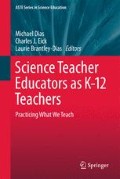Abstract
Most of the professors contributing to this book had spent several years away from teaching children and adolescents, and they yearned to return to K-12 teaching to prove to themselves that they could (still) be effective teachers of youth. They could not move forward as credible people of reform and reform-based practices without putting into practice with K-12 students what they espoused as science educators. The preservice and in-service teachers with whom they worked needed to know, for example, that inquiry learning could be supported in the context of their schools and with their students (Lunenberg et al. 2007). By teaching again, they also aspired to updating and strengthening knowledge and skills in practice, practical knowledge for leading productive learning environments for science (Van Driel et al. 2001). Most of the contributing authors sought to regain credibility with fresh experiences teaching youth of diverse backgrounds and in schools with twenty-first-century technology and high-stakes testing. More boldly, a few ventured into teaching science for the first time, working with learners in grades below their prior teaching experience.
Access this chapter
Tax calculation will be finalised at checkout
Purchases are for personal use only
References
Abd-El-Khalick, F., Bell, R. L., & Lederman, N. G. (1998). The nature of science and instructional practice: Making the unnatural natural. Science Education, 82, 417–436.
American Association for the Advancement of Science (AAAS). (1993). Benchmarks for scientific literacy. New York: Oxford University Press.
Bransford, M. S., & Donovan, J. D. (Eds.). (2005). How students learn: Science in the classroom. Washington, DC: The National Academies Press.
Chiodo, J. J. (2004). Going back to the classroom: From the university to the public school. Clearing House, 77(3), 86–91.
Darling-Hammond, L. (1994). Professional development schools: Schools for developing a profession. New York: Teachers College Press.
Dewey, J. (1910). How we think. Chicago: D.C. Heath.
Fathman, A. K., & Crowther, D. T. (2006). Teaching English through science and science through English. In A. K. Fathman & D. T. Crowther (Eds.), Science for English language learners: K-12 classroom strategies (pp. 3–21). Arlington: National Science Teachers Association Press.
Gallagher, S. A., Stepien, W. J., Sher, B. T., & Workman, D. (1995). Implementing problem-based learning in science classrooms. School Science and Mathematics, 95(3), 136–146.
Glaser, B. G., & Strauss, A. L. (1967). The discovery of grounded theory: Strategies for qualitative research. Piscataway: Aldine Transaction.
Goodlad, J. I. (1994). Educational renewal: Better teachers, better schools (pp. 72–93). San Francisco: Jossey-Bass.
Griffith, G., & Scharmann, L. (2008). Initial impacts of No Child Left Behind on elementary science education. Journal of Elementary Science Education, 20(3), 35–48.
Intrator, S. M., & Kunzman, R. (2009). Grounded: Practicing what we preach. Journal of Teacher Education, 60(5), 512–519.
Korthagen, F. A. (2001). Linking practice and theory: The pedagogy of realistic teacher education. Mahwah: Lawrence Erlbaum Associates.
LaBoskey, V. K. (1994). Development of reflective practice: A study of preservice teachers. New York: Teachers College Press.
Lott, K. H. (2011). FIRE UP the Inquiry. Lose the routine, tweak your “cookbook lab”, and reach a level of open inquiry with these strategies used during a unit on heat. Science and Children, 48(7), 29–33.
Loughran, J. J. (2002). Effective reflective practice: In search of meaning in learning about teaching. Journal of Teacher Education, 53, 33–43.
Lunenberg, M., Korthagen, F., & Swennen, A. (2007). The teacher as a role model. Teaching and Teacher Education, 23, 586–601.
Merriam, S. B. (1998). Qualitative research and case study applications in education. San Francisco: Jossey-Bass.
National Research Council (NRC). (1996). National science education standards. Washington, DC: National Academies Press.
Noddings, N. (1996). Stories and affect in teacher education. Cambridge Journal of Education, 26(3), 435–447.
Posner, G. J. (2000). Field experience: A guide to reflective teaching (5th ed.). New York: Longman.
Robertson, A. (2007). Development of shared vision: Lessons from a science education community collaborative. Journal of Research in Science Teaching, 44(5), 681–705.
Schön, D. (1983). The reflective practitioner: How professionals think in action. New York: Basic Books.
Shulman, L. S. (1988). Teaching alone, learning together: Needed agendas for the new reforms. In L. S. Shulman (Ed.), The wisdom of practice: Essays on teaching, learning, and learning to teach (pp. 325–326). San Francisco: Jossey-Bass.
Shulman, L. S. & Shulman, J. H. (2004). How and what teachers learn: a shifting perspective. Journal of Curriculum Studies, 36(2):257–271.
Sirotnik, K. A. (1999). Making sense of educational renewal. Phi Delta Kappan, 80(8), 606–610.
Tomlinson, C. A., & Imbeau, M. B. (2010). Leading and managing a differentiated classroom. Alexandria: Association for Supervision and Curriculum Development.
Van Driel, J. H., Beijaard, D., & Verloop, N. (2001). Professional development and reform in science education: The role of teachers’ practical knowledge. Journal of Research in Science Teaching, 38, 137–158.
Wenger, E. (1998). Communities of practice: Learning, meaning, and identity. New York: Cambridge University Press.
Zeichner, K. M., & Liston, D. P. (1996). Reflective teaching: An introduction. Mahwah: Erlbaum.
Author information
Authors and Affiliations
Corresponding authors
Editor information
Editors and Affiliations
Rights and permissions
Copyright information
© 2014 Springer Science+Business Media B.V.
About this chapter
Cite this chapter
Eick, C.J., Brantley-Dias, L., Dias, M. (2014). Teaching Youth Again: Reflecting on Renewal. In: Dias, M., Eick, C., Brantley-Dias, L. (eds) Science Teacher Educators as K-12 Teachers. ASTE Series in Science Education, vol 1. Springer, Dordrecht. https://doi.org/10.1007/978-94-007-6763-8_19
Download citation
DOI: https://doi.org/10.1007/978-94-007-6763-8_19
Published:
Publisher Name: Springer, Dordrecht
Print ISBN: 978-94-007-6762-1
Online ISBN: 978-94-007-6763-8
eBook Packages: Humanities, Social Sciences and LawEducation (R0)

